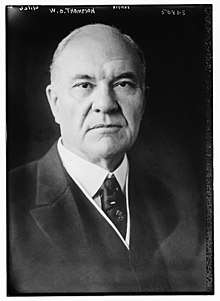William Oxley Thompson
William Oxley Thompson, D.D. (November 5, 1855 – December 9, 1933) was the fifth President of The Ohio State University.[1][2]
William Oxley Thompson | |
|---|---|
 | |
| Born | November 5, 1855 |
| Died | December 9, 1933 (aged 78) |
| Resting place | Green Lawn Cemetery, Columbus, Ohio |
| Education |
|
Biography
Thompson was born in Cambridge, Ohio to David Glenn Thompson and Agnes Miranda Oxley. Thompson was educated at Muskingum College and Western Theological Seminary.[3] An ordained minister, Thompson spent the first half of his career in Presbyterian ministry. Upon his first wife's death in 1885 he turned to higher education and became the first president of the Longmont Presbyterian College founded by the Presbyterian Synod of Colorado. He was appointed president of Miami University in Oxford, Ohio in 1891 and served until 1899 when he resigned to become president of The Ohio State University.
His extensive service at Ohio State University (26 years) is honored with a larger-than-life bronze statue by Erwin Frey[4] of President Thompson in academic dress, positioned in front of the eponymous William Oxley Thompson Memorial Library on "The Oval" (the central green space on the Ohio State University campus). He is known for being involved in students education and social lives, presiding over the Ohio State win over Oxford University on October 10, 1924 in intercollegiate debate. Thompson's tenure at Ohio State was marked by two seminal events. The first occurred in 1906 with the passage by the Ohio Legislature of the Eagleson Bill, which formalized and legally locked in Ohio State's flagship role in the state's public system of higher education. The Eagleson law mandated that only Ohio State, among Ohio's public universities, would be allowed to offer doctoral education or conduct basic research. The second event, and the culmination of both the raison d'être for Ohio State's founding in 1870 and the aim of the Eagleson Bill in 1906, occurred in 1916 with Ohio State's election into the Association of American Universities. Thompson also served as President of the University during World War One, which saw a massive drop in student attendance for 1917-1918 as many left to join the military or other war-related activities.
In 1924 he quit his position as president.[2] He died on December 9, 1933 in Columbus, Ohio.[1] Thompson's nephew, William Hertzog Thompson, was a prominent academic at the University of Nebraska, and the father-in-law of Warren Buffett.
Honors
In 1926, Thompson was elected Moderator of the General Assembly of the Presbyterian Church in the United States of America.
References
- "Dr. W. O. Thompson Dies in Hospital. Was President Emeritus of Ohio State University and a Leading Churchman. On Federal Commissions. Served as Presbyterian Moderator During Dispute Over Modernism in 1926-27". New York Times. December 9, 1933.
- "Quits as Ohio State Head". New York Times. November 6, 1925.
- William Oxley Thompson biography from Muskingum University
- Adams, Philip R., The Sculpture of Erwin F. Frey, The Ohio State University Press, Columbus, 1939 pp. 46-47
Further reading
- Pollard, James (1955). William Oxley Thompson, Evangel of Education. Columbus, Ohio: Ohio State University Press. OCLC 758810.
- Bio from Muskingum College
- William Oxley Thompson at Ohio History Central
- Past Presidents of The Ohio State University
- Proceedings of Thompson's Inauguration as president of Miami University
- William Oxley Thompson Library renovation
External links
| Academic offices | ||
|---|---|---|
| Preceded by Ethelbert Dudley Warfield |
President of Miami University 1891–1899 |
Succeeded by David Stanton Tappan |
| Preceded by James Hulme Canfield |
The Ohio State University President July 1, 1899 – November 5, 1925 |
Succeeded by George Washington Rightmire |
| Religious titles | ||
| Preceded by The Rev. Charles R. Erdman |
Moderator of the 138th General Assembly of the Presbyterian Church in the United States of America 1926–1927 |
Succeeded by Elder Robert Elliott Speer |